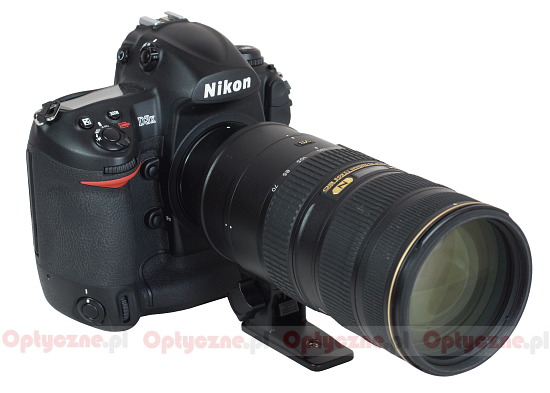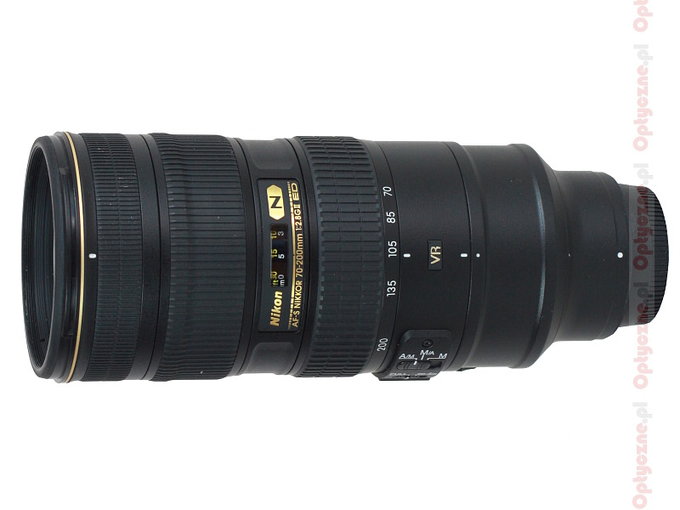Nikon Nikkor AF-S 70-200 mm f/2.8G ED VR II
1. Introduction
Not so long ago it seemed that Nikon didn’t have to change anything in its offer of 70-200 mm class journalistic lenses. The company offered its customers two models: the AF 80–200mm f/2.8D ED, which was characterized by good price/quality ratio but lacked an in-build AF motor and stabilization and the AF-S 70–200 mm f/2.8G IF-ED VR, which was a better lens, more expensive but stabilized.
At first glance everything was fine. The latter device was launched in 2003 so already during the digital era – small wonder its optics and coatings met the demands of digital cameras’ sensors. Also other elements of the lens met current standards – the ultrasonic autofocus motor was silent, quick and accurate and the stabilization system as efficient as about 3 EV.
Please Support UsIf you enjoy our reviews and articles, and you want us to continue our work please, support our website by donating through PayPal. The funds are going to be used for paying our editorial team, renting servers, and equipping our testing studio; only that way we will be able to continue providing you interesting content for free. |
- - - - - - - - - - - - - - - - - - - - - - - - - - - - - - - - - - - - - - - - - - - - - - - -
Did Nikon had any reason to replace that lens with a new one? If we try to answer this question we have to move back in time, to the beginnings of the era of digital Nikon reflex cameras. At that time the company decided to use the DX sensor format (1.5x multiplier) in its whole range of products, from those the most amateurish (at first it was the D70 model) through half-professional (D100 model) to the high-end, fully professional models of the D1 and D2 class. Nikon seemed to be very sure they did the right thing. I remember perfectly well those training courses and workshops given by the Nikon Poland employers, during which the DX format was presented as an example; they argue convincingly (and they were right) that the consistent use of the DX format, along with appropriately designed lenses, would allow to get images with very limited level of off-axis aberrations. They tried to present the uniformity and consistency in building the whole system as an additional advantage; the movements of the main competitor, Canon, which couldn’t decide whether to use 1.6, or 1.3 multiplier or the full frame, were considered a mistake.
What’s interesting, Nikon didn’t stop manufacturing full frame lenses at that time. At the beginning of the 21st century a lot of photographers still have been using analogue cameras and it would be difficult to deprive them of good lenses. The Nikkor AF-S 70–200 mm f/2.8G IF-ED VR seems to be the child of those times. In principle it is designed to work on full frame but produced with the assumption that the whole digital world will use it on DX sensors. As it was shown in our test, that lens indeed performed superbly on the sensor of the Nikon D200.
In 2007 the company’s philosophy changed and the Nikon D3 was launched – the first full frame digital reflex camera of this producer. With this and several other launches some problems arose, though. There have been signals from the market that the Nikkor AF-S 70–200 mm f/2.8G IF-ED VR, being a fully professional and very expensive device, doesn’t fare as it should at the edge of full frame. Most of the complaints concerned huge vignetting and that was predictable – one glance at a very narrow Nikkor’s casing was enough to expect such issues.
Nikon soon reached a point where they decided to replace the Nikkor AF-S 70–200 mm f/2.8G IF-ED VR, not a very old device after all, with a new model. What’s interesting, it overlapped with the replacements of 70-200 mm models from Canon and Sigma. We’ve been given a splendid opportunity to compare all these lenses and our comparison will be started by precisely the new Nikkor AF-S 70–200 mm f/2.8G ED VR II.
We would like to thank Nikon Poland for lending us the lens for the test.
You are also invited to get acquainted with our test procedure, described in the article "How do we test lenses?" If you feel it’s still not enough, please go to our FAQ section where you can find some further explanation.
 |







